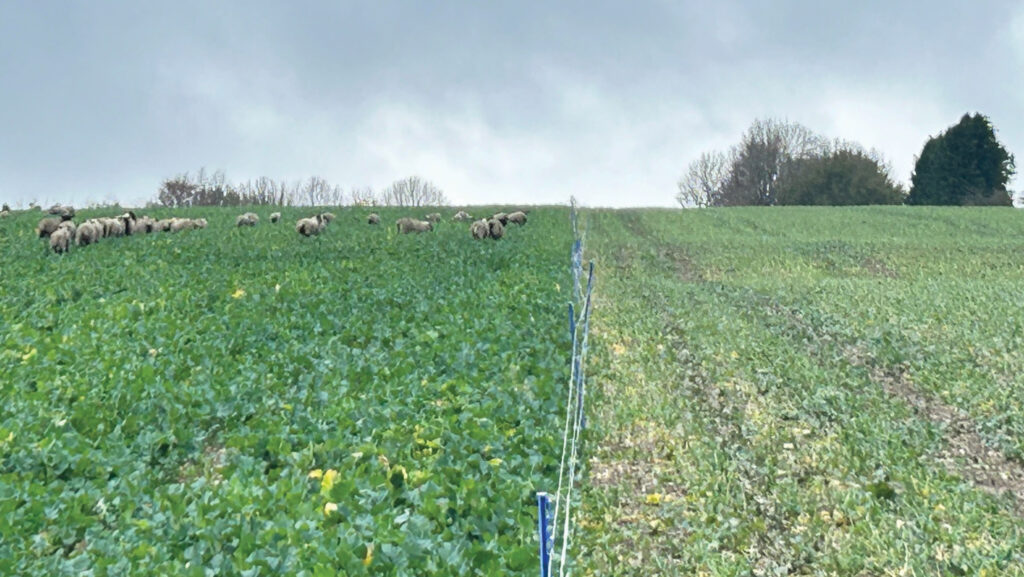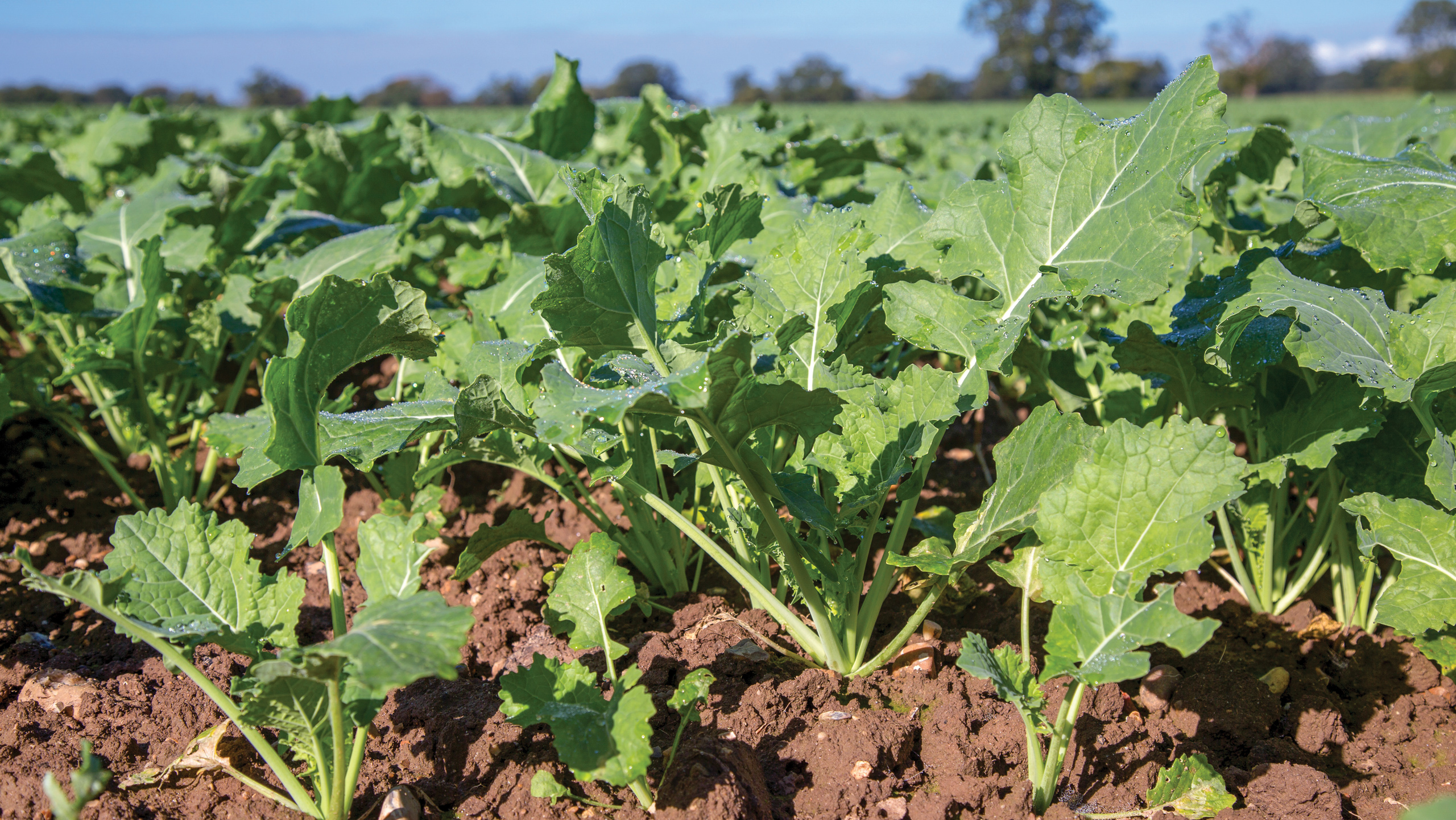Wilts OSR grower reveals lessons from sheep grazing trials
 © JM Stratton
© JM Stratton If the timing is right, grazing oilseed rape with sheep in the autumn can improve crop evenness and deliver yield benefits, according to one Wiltshire farmer.
At East Farm near Warminster, farmer Josh Stratton has been putting the system to the test.
See also: Sheep grazing eliminates need for rapeseed growth regulators
Running 1,800ha, with 1,400ha in arable production alongside pasture, forestry and a beef herd, he has trialled grazing across large blocks of OSR for the past two seasons, to measure the impact on both pest levels and yields.
The farm’s arable system is based on a seven-year rotation, giving flexibility while spreading risk across different crops.
“We only grow first wheats rather than pushing into second wheats,” says Josh, who is a Farmers Weekly Transition Farmer. “Wheat is then usually followed by either winter or spring barley, and after that we’ll bring OSR into the sequence.
“Oats or peas often follow spring barley, before the rotation comes back round to wheat.”
This approach helps spread workload and manage risk. “By keeping five different crops in the system, we’re able to reduce disease pressure and keep the soil productive,” he adds.

Josh Stratton © JM Stratton
How the trial worked
Like many growers, Josh has been looking for alternative ways to tackle cabbage stem flea beetle and manage forward crops. Grazing sheep offered a potential biological solution.
“We first grazed OSR in autumn 2023 when crops were very forward and the pressure from flea beetle was high,” Josh recalls.
“We ran a trial with different grazing intensities across one field and counted larvae numbers. The harder it was grazed, the fewer larvae we found, and those crops went on to yield better. It was a clear benefit.”
However, the following year was less straightforward. Autumn 2024 brought lower flea beetle pressure, and grazing coincided with a drought later in the year.
“We probably grazed some crops a bit too hard in December 2024 and left the sheep on a little too long,” Josh reflects. “We went from a very wet spell into a very dry one, and the crop just never recovered.”
The grazing experiments sit alongside Josh’s wider focus on environmental management. “We have a very low-intensity beef herd, a bit of forestry, and quite a strong environmental programme,” he says.
“We’re very focused on biodiversity, soil health and clean water – it’s quite an intensive programme of environmental uplift.”
That ethos complements the grazing trials, as sheep can help to reduce chemical use and support crop rotations while fitting into a farm system already geared towards biodiversity. “The principle is a good one, but it has to work for the crop first,” he says. “If grazing supports yield and fits the season, it’s worth doing. If not, you’re better leaving the sheep off.”
What the trials showed
Over the past two seasons, Josh grew 175ha of OSR, with about two-thirds grazed by sheep and selected blocks left ungrazed to provide a comparison. This gave him the chance to see both the benefits and the risks of the approach under different conditions.
In harvest 2024, the yield difference between the best and worst areas was 1t/ha, he notes. “The harder the crop was grazed, the better the yield, as the sheep rid the crop of flea beetle larvae in the stems. In harvest 2025, the contrast was that where grazing was done early, crops came back strongly, whereas later grazing set them back as the crop was reluctant to tiller because of drought.” He points out that the differences were obvious even within the same fields, with early grazing producing strong results while later-grazed sections struggled to recover.
Grazing also offered some modest savings on inputs. “We probably reduced fungicide costs in the spring because there was less leafy growth to harbour disease,” Josh explains.
“But fungicides on OSR don’t cost a lot, so I wouldn’t say it was a huge saving. In the end, it’s all about yield. If you get 1t/ha more of anything, or even 0.5t/ha, at £450/t, that’s what makes the difference. A few cost savings are completely irrelevant in comparison. What I wouldn’t do is graze a field if there was any risk of reducing yield, because it just isn’t worth it.”
In terms of timing, the typical window for grazing is about 10 weeks. “We would normally graze from the beginning of October to the middle of December,” he explains.

© GNP
This season
“It really depends on the year. Looking back, the past two years we probably should have started earlier, but our shepherd wasn’t ready.
“We definitely don’t want to start before the crop is ready, so we’ll be watching it carefully. At the moment, with the warm weather, it is going to grow really quickly.
“Now it’s established, it should grow well, so we’ll just see how it all looks.”
For Josh, the conclusion is clear; grazing must never compromise output. “The soil health benefits are really marginal,” he says.
“For the amount of time the sheep are on, they’re not going to add much organic matter, and you risk compaction if they’re left too long. It might look good, but if you lose 0.5t/ha that’s £450/ha gone, and you haven’t really gained anything.
“Quite a few farmers thinking about regen programmes see grazing as a good thing, and it can be, but my advice is never compromise on yield.”
Josh is now extending his grazing trials beyond OSR, with a new project focused on winter wheat. He is doing a wheat trial with Goldfinch, which has barley yellow dwarf virus (BYDV) resistance.
“The idea is that we plant early, don’t use insecticides, and then graze the crop over winter.
“The grazing should do the job of growth regulation, disease control and BYDV control. We haven’t tried this before, so it’s completely new for us this year.”
He sees clear potential for grazing to play a bigger role in arable systems, provided the right conditions are in place. “I don’t see why it couldn’t work across the UK,” he says.
Josh says the key thing is having a really good grazier nearby. Most arable farms have lost all their livestock skills.
“We certainly don’t want to run our own sheep, it would be a complete disaster,” he admits. “But if you can find someone local, invest in that relationship, and trust them to do the job properly, it can work well.”
For Josh, the grazing income itself is of little importance compared with crop yield. “We charge half the market rate for grazing, because the income is less important,” he stresses.
“It’s irrelevant compared to yield. If a grazier comes from 100 miles away and makes a mess of the place, any income you make is instantly wiped out by yield losses.
“For us, grazing only makes sense if it improves crop performance. If not, don’t do it.”
Practical advice for other farmers
- Work with a reliable grazier “You need someone honest and responsive, who will move stock promptly,” Josh advises. “If they won’t shift sheep on a Sunday when needed, you’ll overgraze and pay for it in yield.”
- Invest in fencing Strong temporary fencing is essential to make the logistics manageable. A reliable water supply is less critical in autumn – sheep generally don’t need much – but having a grazier who will handle both fencing and stock moves is ideal.
- Start small and know your purpose “Don’t just do it because it sounds like a good idea,” he cautions. “Be clear on what you want to achieve – pest control, growth regulation, evening-up crops – and build it up slowly.”
- Don’t start too early Timing is critical. Allow the crop to establish properly before grazing begins, otherwise regrowth can be compromised.

